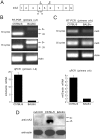Two genetic determinants acquired late in Mus evolution regulate the inclusion of exon 5, which alters mouse APOBEC3 translation efficiency
- PMID: 22275865
- PMCID: PMC3262013
- DOI: 10.1371/journal.ppat.1002478
Two genetic determinants acquired late in Mus evolution regulate the inclusion of exon 5, which alters mouse APOBEC3 translation efficiency
Abstract
Mouse apolipoprotein B mRNA-editing enzyme catalytic polypeptide-like editing complex 3 (mA3), an intracellular antiviral factor, has 2 allelic variations that are linked with different susceptibilities to beta- and gammaretrovirus infections among various mouse strains. In virus-resistant C57BL/6 (B6) mice, mA3 transcripts are more abundant than those in susceptible BALB/c mice both in the spleen and bone marrow. These strains of mice also express mA3 transcripts with different splicing patterns: B6 mice preferentially express exon 5-deficient (Δ5) mA3 mRNA, while BALB/c mice produce exon 5-containing full-length mA3 mRNA as the major transcript. Although the protein product of the Δ5 mRNA exerts stronger antiretroviral activities than the full-length protein, how exon 5 affects mA3 antiviral activity, as well as the genetic mechanisms regulating exon 5 inclusion into the mA3 transcripts, remains largely uncharacterized. Here we show that mA3 exon 5 is indeed a functional element that influences protein synthesis at a post-transcriptional level. We further employed in vitro splicing assays using genomic DNA clones to identify two critical polymorphisms affecting the inclusion of exon 5 into mA3 transcripts: the number of TCCT repeats upstream of exon 5 and the single nucleotide polymorphism within exon 5 located 12 bases upstream of the exon 5/intron 5 boundary. Distribution of the above polymorphisms among different Mus species indicates that the inclusion of exon 5 into mA3 mRNA is a relatively recent event in the evolution of mice. The widespread geographic distribution of this exon 5-including genetic variant suggests that in some Mus populations the cost of maintaining an effective but mutagenic enzyme may outweigh its antiviral function.
Conflict of interest statement
The authors have declared that no competing interests exist.
Figures









Similar articles
-
Apobec-mediated retroviral hypermutation in vivo is dependent on mouse strain.PLoS Pathog. 2024 Aug 29;20(8):e1012505. doi: 10.1371/journal.ppat.1012505. eCollection 2024 Aug. PLoS Pathog. 2024. PMID: 39208378 Free PMC article.
-
Expression of murine APOBEC3 alleles in different mouse strains and their effect on mouse mammary tumor virus infection.J Virol. 2009 Apr;83(7):3029-38. doi: 10.1128/JVI.02536-08. Epub 2009 Jan 19. J Virol. 2009. PMID: 19153233 Free PMC article.
-
Adaptive evolution of Mus Apobec3 includes retroviral insertion and positive selection at two clusters of residues flanking the substrate groove.PLoS Pathog. 2010 Jul 1;6(7):e1000974. doi: 10.1371/journal.ppat.1000974. PLoS Pathog. 2010. PMID: 20617165 Free PMC article.
-
Alternative mRNA splicing and differential promoter utilization determine tissue-specific expression of the apolipoprotein B mRNA-editing protein (Apobec1) gene in mice. Structure and evolution of Apobec1 and related nucleoside/nucleotide deaminases.J Biol Chem. 1995 Jun 2;270(22):13042-56. doi: 10.1074/jbc.270.22.13042. J Biol Chem. 1995. PMID: 7768898
-
Mouse APOBEC3 Restriction of Retroviruses.Viruses. 2020 Oct 27;12(11):1217. doi: 10.3390/v12111217. Viruses. 2020. PMID: 33121095 Free PMC article. Review.
Cited by
-
APOBEC3 inhibition of mouse mammary tumor virus infection: the role of cytidine deamination versus inhibition of reverse transcription.J Virol. 2013 May;87(9):4808-17. doi: 10.1128/JVI.00112-13. Epub 2013 Feb 28. J Virol. 2013. PMID: 23449789 Free PMC article.
-
Apobec-mediated retroviral hypermutation in vivo is dependent on mouse strain.PLoS Pathog. 2024 Aug 29;20(8):e1012505. doi: 10.1371/journal.ppat.1012505. eCollection 2024 Aug. PLoS Pathog. 2024. PMID: 39208378 Free PMC article.
-
Evolution of different antiviral strategies in wild mouse populations exposed to different gammaretroviruses.Curr Opin Virol. 2013 Dec;3(6):657-63. doi: 10.1016/j.coviro.2013.08.001. Epub 2013 Aug 28. Curr Opin Virol. 2013. PMID: 23992668 Free PMC article. Review.
-
Mouse knockout models for HIV-1 restriction factors.Cell Mol Life Sci. 2014 Oct;71(19):3749-66. doi: 10.1007/s00018-014-1646-8. Epub 2014 May 23. Cell Mol Life Sci. 2014. PMID: 24854580 Free PMC article. Review.
-
Friend retrovirus studies reveal complex interactions between intrinsic, innate and adaptive immunity.FEMS Microbiol Rev. 2019 Sep 1;43(5):435-456. doi: 10.1093/femsre/fuz012. FEMS Microbiol Rev. 2019. PMID: 31087035 Free PMC article. Review.
References
-
- Chen H, Lilley CE, Yu Q, Lee DV, Chou J, et al. APOBEC3A is a potent inhibitor of adeno-associated virus and retrotransposons. Curr Biol. 2006;16:480–485. - PubMed
-
- Esnault C, Heidmann O, Delebecque F, Dewannieux M, Ribet D, et al. APOBEC3G cytidine deaminase inhibits retrotransposition of endogenous retroviruses. Nature. 2005;433:430–433. - PubMed
Publication types
MeSH terms
Substances
Grants and funding
LinkOut - more resources
Full Text Sources
Molecular Biology Databases

